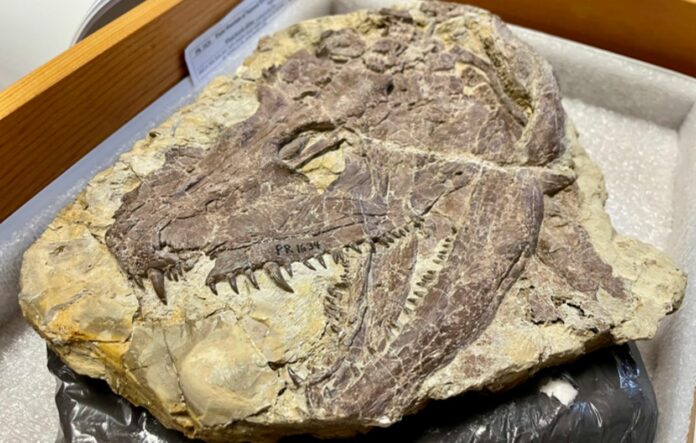The Field Museum in Chicago has the largest and most complete remains of a prehistoric superpredator that roamed hundreds of millions of years even before T. rex.
The relics of the six-foot-long, salamander-like, lake-dwelling Whatcheeria were found in a limestone quarry near the Iowa town of What Cheer.
About 350 Whatcheeria specimens, from single bones to whole skeletons, have been found, and all of them are in the Field Museum’s collection.
These specimens were used in recent research published in Communications Biology that shed light on how Whatcheeria developed to become a formidable predator of fish. Rather than becoming “slow and steady” like many modern reptiles and amphibians, Whatcheeria developed quickly during its juvenile years.
“If you saw Whatcheeria in life,” explains co-author Ben Otoo, “it would probably look like a big crocodile-shaped salamander, with a narrow head and lots of teeth.
“If it really curled up, probably to an uncomfortable extent, it could fit in your bathtub, but neither you nor it would want it to be there.”
Because Whatcheeria was a very good hunter. Skull grooves for sensory organs found only in fish and aquatic amphibians indicate that this creature spent its life underwater, and its robust leg bones may have helped it stay put while waiting for food to swim by.
“It probably would have spent a lot of time near the bottoms of rivers and lakes, lunging out and eating whatever it liked,” remarks Otoo. “You definitely could call this thing ‘the T. rex of its time.’”
Whatcheeria is a “stem tetrapod,” an early four-legged creature that was an ancestor of the four-limbed creatures that are living today, despite having the appearance of a huge salamander.
“Whatcheeria is more closely related to living tetrapods like amphibians and reptiles and mammals than it is to anything else, but it falls outside of those modern groups,” according to co-author Ken Angielczyk. “That means that it can help us learn about how tetrapods, including us, evolved.”
Because there are so many Whatcheeria specimens in the Field, scientists can use them to study the animal at different times in its life. According to Angielczyk, “most early tetrapods are known from just one skeleton if you’re lucky— in a lot of cases just a fragment of a single bone.”
However, since the Field is home to such a large number of animals, scientists have been able to identify diversity within the species: some Whatcheeria are as large as six and a half feet, while others are considerably smaller. That implies that it was possible to examine their growth.
Otoo and Angielczyk brought in thigh bones of nine Whatcheeria, from young to old, so they could see how they grew. Stephanie Pierce from Harvard University, Whitney’s adviser, used tiny slices of bone to analyze under a microscope.
Every growth season, an animal adds new layers of bone, according to Otoo.
“You might see a seasonal pattern where the animal is growing a lot during the spring and summer and then stopping in winter and resuming the next spring,” the author highlight. “By examining how thick the growth rings are over the course of an animal’s life, you can figure out if the animal’s growing continuously throughout its lifetime, perhaps with some temporary interruptions, or basically growing to an adult size, then stopping.”
Some contemporary tetrapod creatures, including birds and mammals like ourselves, develop rapidly as juveniles before ceasing to grow as adults. Other creatures, including crocodiles and many amphibians, on the other hand, continue to develop slowly throughout their whole lives. Whatcheeria was predicted by the researchers to develop “slow and steady,” more like reptiles and amphibians. But after looking at the bone slices, Whitney discovered proof that Whatcheeria first expanded quickly before slowing down over time. She even discovered fibrolamellar bone, the main bone component linked to rapid development.
“I have a very distinct memory of jumping on Slack with Stephanie Pierce and saying, this breaks all of the rules that we thought of for how growth is evolving in these early tetrapods,” adds Whitney.
The finding sheds light on several aspects of Whatcheeria’s daily existence.
“If you’re going to be a top predator, a very large animal, it can be a competitive advantage to get big quickly as it makes it easier to hunt other animals, and harder for other predators to hunt you,” adds Pierce. “It can also be a beneficial survival strategy when living in unpredictable environments, such as the lake system Whatcheeria inhabited, which went through seasonal dying periods.”
However, getting huge rapidly requires a lot of energy, which might be problematic if the animal doesn’t have adequate food and resources. It’s simple to pay smaller monthly rent payments than saving for a hefty housing downpayment, just as it’s easier to buy just enough food to grow.
Researchers believe the results serve as a reminder that evolution is a series of experiments rather than a tidy, sequential process and help us understand the evolutionary pressures on early tetrapods.
“Evolution is about trying out different lifestyles and combinations of features,” adds Angielczyk. “And so you get an animal like Whatcheeria that’s an early tetrapod, but it’s also a pretty fast-growing one. It’s a really big one for its time. It has this weird skeleton that’s potentially letting it do some things that some of its contemporaries weren’t. It’s an experiment in how to be a big predator, and it shows how diverse life on Earth was and still is.”
Image Credit: By Kate Golembiewski, Field Museum
Source: 10.1038/s42003-022-04079-0
